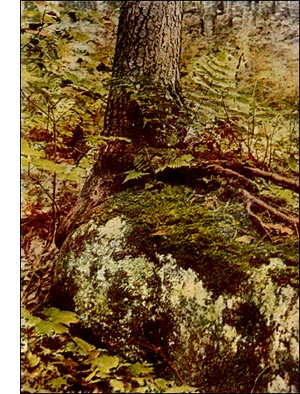Top Moss
 Top-moss, Physcomitrium turbinatum, Muell. ined.
Top-moss, Physcomitrium turbinatum, Muell. ined.Habit and habitat.-Top-moss is everywhere common in old fields and grassy open places in gardens. It is conspicuous both with and without spore-cases, and may be easily recognised from its picture. In September and October the bright-green rosettes of both male and female plants may be found in loose clusters growing on the ground in protected spots, and if examined with a compound microscope, may reveal the archegonia and antheridia. About the middle of May the same locality should show colonies of plants with their perfect spore-cases on slender pedicels (setae).
One is almost sure of finding this moss about flower-pots in green-houses where the ground has not been too recently worked over. The shape of the spore-cases, the contraction below the mouth of the dry spore-case and the .amount of thickening of the elongated cells about the mouth, and the degree of roughness of the spores, all depend upon the stage reached in their development before they become dry and shrivelled; and again the stage in their development depends upon the amount of rain and heat in their environment.
The differences resulting from changes in environment were shown in an interesting manner by plants examined from pots which were under steam-pipes in comparative darkness in the New York Botanical gardens. In September the plants were small with pedicels only about half an inch long. In January the pots were removed to benches with bottom heat and more light and then plants were developed with pedicels twice as long, paler of colour, and with spore-cases more top-shaped and smaller.
Name.-The specific name, turbinatum, the Latin for "pointed like a top," refers to the top-shaped spore-case.
Plants (gametophyte).-Light-green, stems short and simple, or taller and branching, 3/10 to 1 inch long.
Leaves. -Broadly-lance-shaped or egg-shaped with the broad end tapering toward the stem (obovate) ; margin serrate above the middle; vein vanishing below the apex or extending beyond to form a tapering point. Cells, the lower oblong, the upper rhomboidal or hexagonal, the marginal longer and narrower, often yellow and inflated at their upper ends.
Veil (calyptra).-Conical, oblique, and cleft unequally 5- to 8-lobed and beaked, covering about half the spore-case.
Spore-case. -Erect, green and round pear-shaped when fresh; becoming dark-brown, and urn-shaped, often contracted below the rim, when dry and empty.
Pedicel (seta).-Erect or twisted, sometimes arched, 1/4 to 3/4 of an inch long.
Lid (operculum).-Convex or tipped with a small nipple (mammillate) occasionally with an acute point (apiculate).
Teeth (peristome).-None; the rim is bordered by 8 to 12 rows of transversely, elongated cells, the uppermost very narrow and orange-coloured.
Annulus.--Persistent, of transparent, bladder-like cells incurved after the falling of the lid.
Spores, -Rough, maturing in spring.
Distribution.-Ontario to Florida, west to the Rocky Mountains.